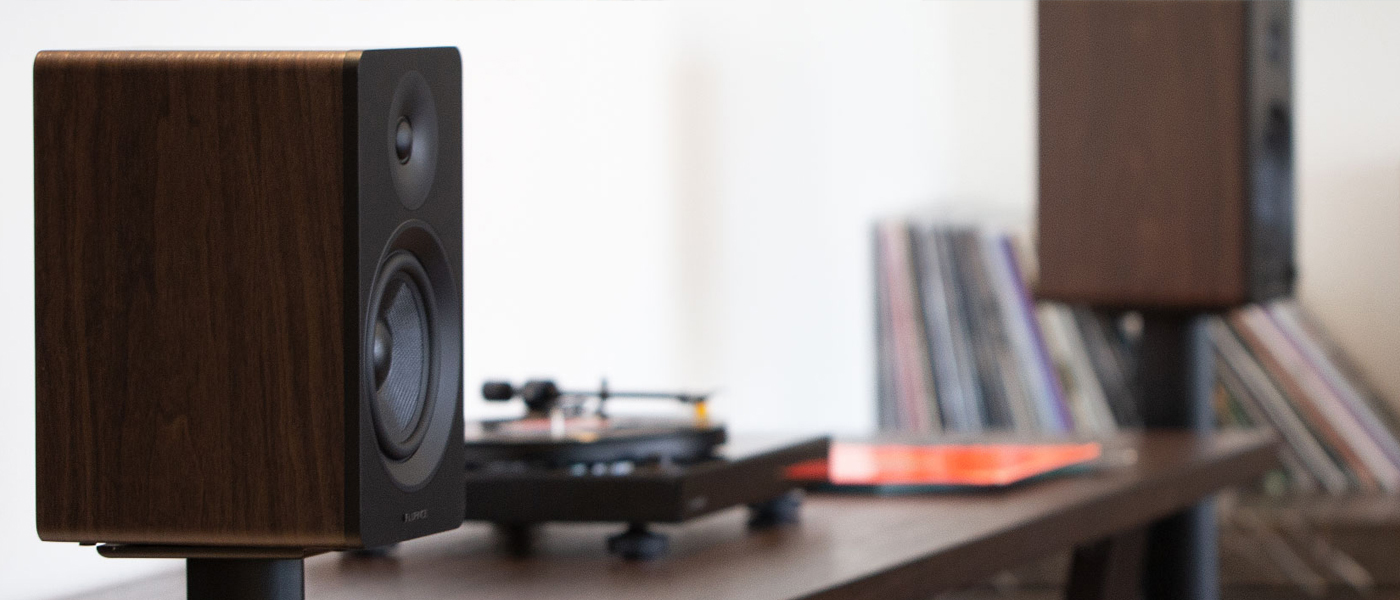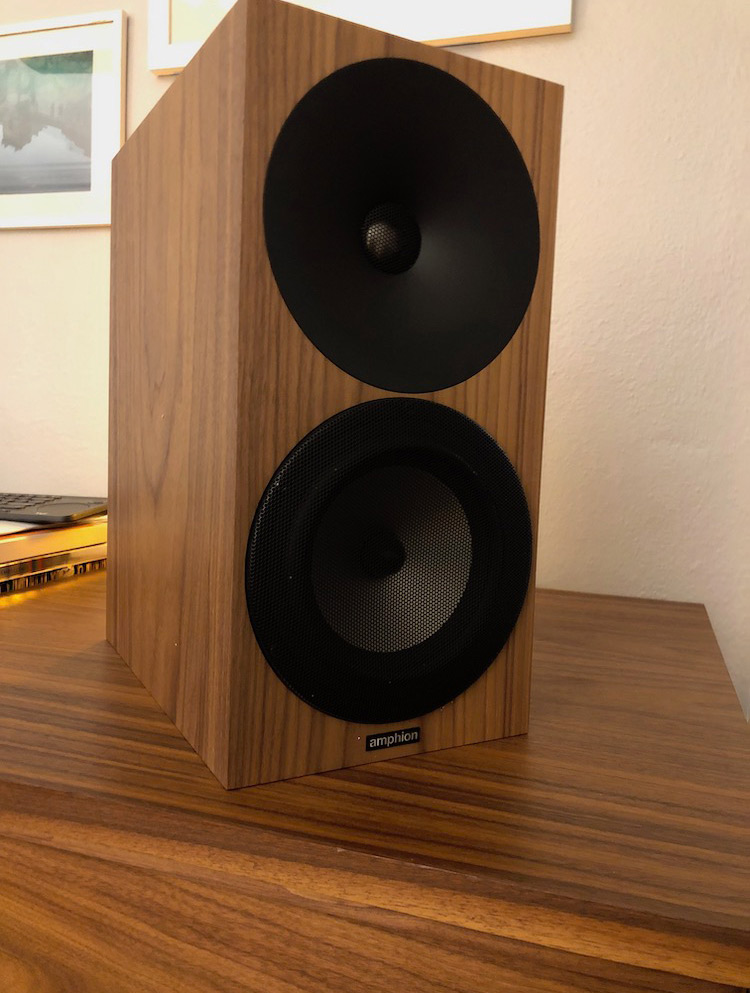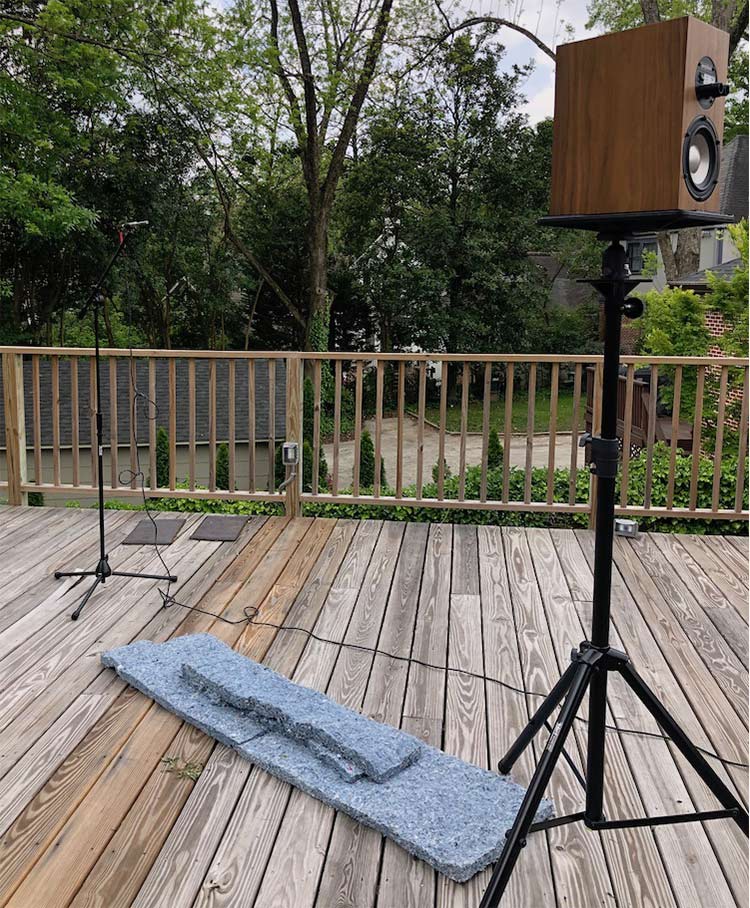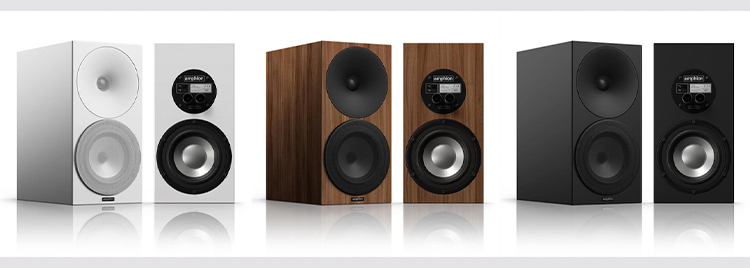
Its furniture-grade cabinet contains a rear-mounted passive radiator and a large waveguide for the tweeter. Amphion claims the Argon 3S is “almost completely insensitive to the acoustics of your listening room.”

Amphion Argon 3S Bookshelf Speaker
- 2-way with waveguide-loaded tweeter
- Passive radiator bass loading
- Luxurious walnut veneer cabinet
- Uncommonly low crossover point
- Highly analytic sound
- Voiced for flat power response
Finland’s Amphion Loudspeakers Ltd. Is best known for their studio monitors today. However, Amphion actually started out in 1998 as a home speaker company. Only later did Amphion speakers start appearing as monitors in recording studios large and small. Amphion speakers are designed and crafted in Finland.
Today Amphion has two distinct product lines: “enjoy” for home listening and “create” for studio monitoring. “Enjoy” has three levels, named for noble gases: Helium, Argon, and Krypton. The Argon line most closely resembles their studio monitors. Amphion claims the Argon 3S “bring to the home audio environment the same technologies which allow sound engineers and artists to ‘see’ deeper into their recordings.” Did they succeed? Keep reading to find out.
Description:
2-way bookshelf speaker
Tweeter:
1” titanium dome in a custom round waveguide, integrated grille
Woofer:
6.5” aluminum with cast frame, integrated grille
Crossover frequency:
1600Hz
Bass loading:
rear-mounted passive radiator
Crossover point:
1.6kHz, order not provided
Controls:
+1dB tweeter switch
Maximum power:
200W
Country of Origin:
Finland
Weight:
26 lbs (12kg)
Dimensions:
15” H x 7.5” W x 12” D (380 x 191 x 305 mm)
MSRP:
$2940/pr. (walnut veneer, as reviewed); starts at $2690
Company:
SECRETS Tags:
Amphion, Amphion Argon 3S, loudspeakers, bookshelf speakers, speaker reviews 2019, speaker measurements, polar map, power response, directivity index, DI
- Revel Performa M126Be
- Revel Performa M106: Part 1
- Revel Performa M106: Part 2
- Revel Performa M106: Part 3
- NHT C3
Amphion’s acoustic design for the Argon 3S is elegant and spare-no-expense: waveguide-enhanced tweeter, passive radiator bass loading, and quality European drive units. Amphion is adamant that they do not target any particular target. According to the Argon 3S’s designer, Martin Kantola, “to me, the design target should primarily never be a technically defined response, but a musically correct one. The way the loudspeaker handles music is what matters.” Kantola further posits that both home speakers and studio monitors should be so voiced: “This applies equally to when one is making music as well as to when one is enjoying it. A correct musical response helps to make the right choices in recording, mixing and mastering, and will also produce the desired emotional reaction when listening to the end result.”
Secrets Sponsor
Based on the large waveguide, Amphion must consider a smooth blend between woofer and tweeter important for a “musically correct” response. There is inherent tension between smooth midrange and decent bass in a 2-way speaker. Decent bass requires a large woofer cone area, but the bigger the woofer the lower in frequency it starts beaming. That is problematic because a tweeter has wide dispersion until the very top of its range. In a standard 2-way with a flush-mounted tweeter and 6″-7″ woofer, that results in a dispersion disruption through the crossover region. This dispersion disruption is often audible as upper-midrange coloration.
Amphion resolves this tension by loading the tweeter in a round, shallow waveguide that restricts its dispersion to match the woofer’s dispersion at the intended crossover. Amphion was among the first HiFi speaker makers to grasp the power of waveguide technology to improve home speakers by reducing or eliminating this dispersion disruption. The waveguide should not only improves the sound for the optimally-seated listener but also increase the size of the sweet spot by making the off-axis response smoother.

A waveguide also boosts the tweeter’s frequency response at the bottom of its passband and reduces its harmonic distortion. Here, Amphion exploits these benefits by setting an uncommonly low crossover point: 1600Hz. A 1” dome tweeter, even a rugged one like Amphion’s, would not long survive such a low crossover frequency without the boost and distortion reduction offered by a waveguide.
While Amphion has long used waveguides, passive radiator bass loading is new for the Argon 3S. The previous Amphion Argon 3 used a standard vent rather than a passive radiator. A passive radiator is basically a woofer minus the motor, tuned to the desired resonance by adding mass to the moving parts.

Amphion’s metal-coned passive radiator is, like its woofer, custom-made for Amphion by Seas of Norway. The standard poly-cone Seas passive radiator is shown above.
A good passive radiator is at least 100x more expensive than a simple port tube, but a passive radiator allows a small cabinet to reach quite deep into the bass. A low-tuned port will occupy significant volume inside a small cabinet, but a passive radiator occupies the same cabinet volume regardless of tuning. Furthermore, a passive radiator does not have pipe resonances to color the sound. Pipe resonances can be very high from a large port in a small cabinet.
However, despite what salespeople – and even some reviewers! – may claim, a passive radiator no more adds to the cone area or volume displacement of a speaker than a port does. A passive radiator also rolls off similarly to a port below tuning. Deep bass (below the tuning frequency) will also “unload” a passive radiator system just as it will a ported system, leading to large woofer excursions with little output and high distortion below the cabinet tuning.
Like its acoustic design, the Amphion 3S’s industrial design is mostly elegant, albeit with a few quirks. The cabinets are deeper than wide. Their heft suggests heavy bracing and dense material.
From the front, the Amphion Argon 3S is very attractive, with a clean Scandinavian aesthetic. My review pair looked like fine wood furniture, with a satin finish that showcases the walnut grain with refinement rather than ostentation. The separate woofer and tweeter grilles strike a nice balance between protecting the drive units and showing them off. Amphion’s design is more expensive than a full-face grille but really dresses up the speaker. Amphion also provides a touch of that Scandinavian design whimsy with grille color options:
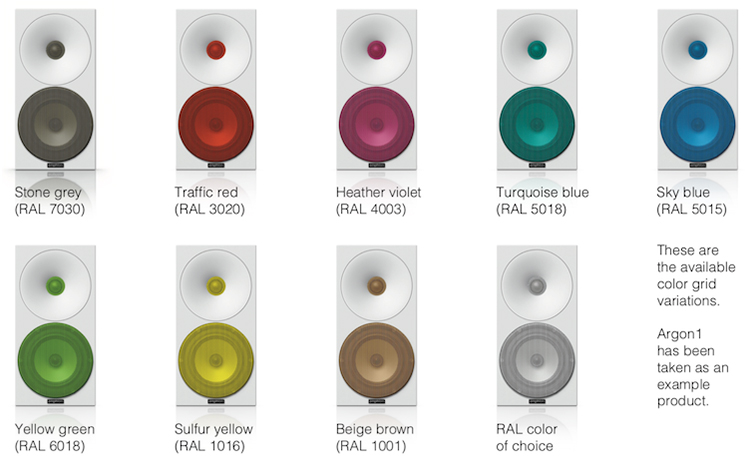
Amphion offers a full-face cloth grille as a $60 add-on, but I see no need for it.

Around back the Amphion Argon 3S loses a little design mojo. Here, an incongruous audiophile affectation appears: cartoonishly large binding posts.
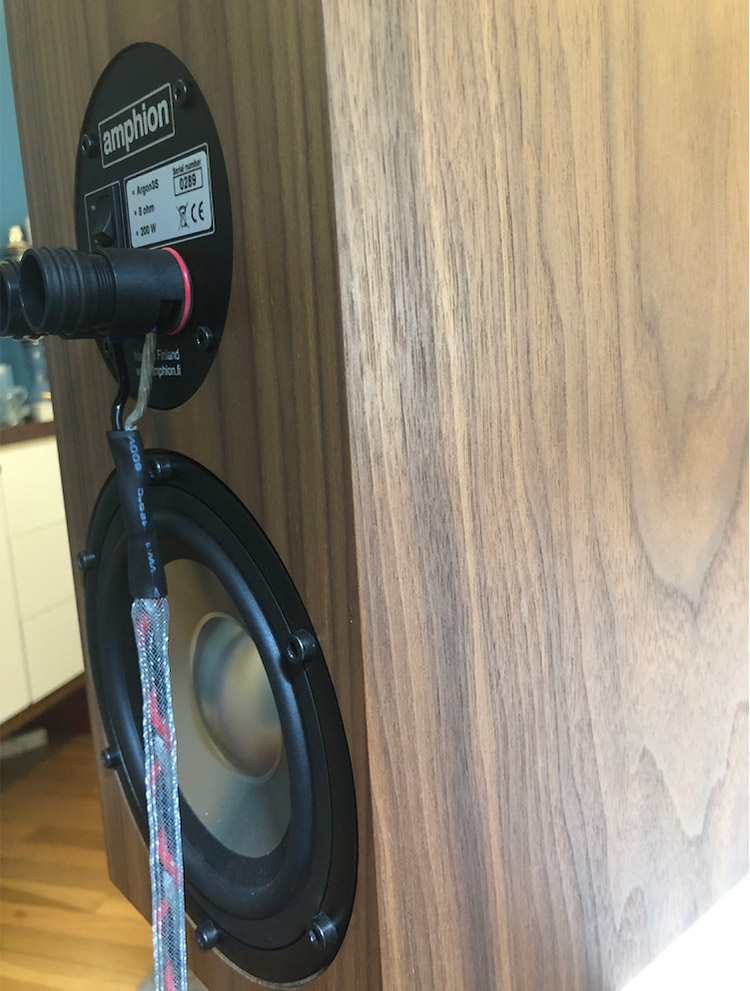
I’m sure these posts are expensive, but I don’t like them. For spades and bare wire, there is only one conductive surface, as the screw-clamp is plastic. Amphion recommends you remove the plastic screw clamp to use banana plugs, but that is obviously a bad idea. Removing the caps just means you’ll lose them or throw them away and never again be able to use anything but bananas! Even with the screw clamp removed, there is a deep (3/4”/19mm) recess, so angled binding posts (I tried WBT and Wireworld) still don’t fit. You can use bananas with the screw clamp on, but they nest so deeply that you have to pull on the wire, rather than the plug, to remove a speaker lead. Their previous model used standard binding posts that were functionally and ergonomically superior.
Additionally, speaker wires routed above a passive radiator is not great design. Dangling leads can contact the passive radiator, as you can see above. I would’ve liked to see some protection for the passive radiator or some sort of guide to route speaker wires away from it. If you hear a buzz coming from an Amphion Argon 3S on bass-heavy music, make sure your speaker wires aren’t touching the passive radiator.
Lastly, Amphion includes a switch on the back to boost the treble level by 1dB. Based on my listening notes and their measured performance, a switch to reduce the treble may have been a better choice.
I placed the Argon 3S on 30” tall steel stands, taller than usual because I sit up higher when I’m listening carefully. They were placed about 10’ apart and 3’ from the rear wall, with a listening distance of 12’. I started with them toed in such that their axes crossed on the tip of my nose. I played with varying degrees of rotation and found the best combination of treble balance, spaciousness, and image focus with the Argon 3S’s toed in to cross about 18” in front of my nose. That is my typical toe-in for waveguide and concentric driver speakers. So placed, they provided a very similar tonal balance across all three seats of an 84” wide sofa, and little difference when seated vs. standing.
Secrets Sponsor
My review pair had some show demo use before I received them. Regardless, their sonic character remained stable from first unboxing to repacking. I observed no “break-in.” All of my listening was 2.0-channel, but with room correction (Anthem ARC, later ARC Genesis) below 250Hz. Research shows that bass quality accounts for 30% of listener opinion of a speaker. However, rooms impose their will on speakers in the bass. Moreover, I never listen to my reference system without correction, so why would I kneecap review speakers by eschewing room correction? I fit the room gain in ARC to the speakers’ natural response, i.e. about a 1.5dB upper bass lift. Here is the readout from ARC Genesis, showing the equalized portion in red.
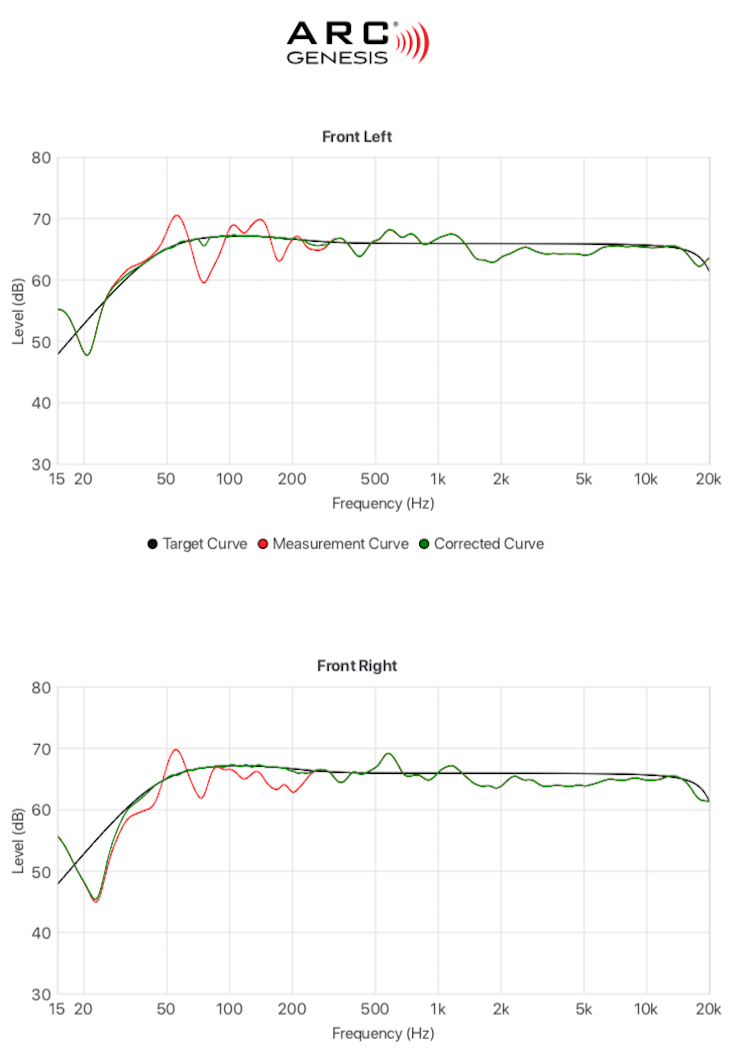
The Amphion Argon 3S were SPL limited on bass torture tracks such as Massive Attack’s “Angel.” At higher volumes, they grew blatty (as expected) but in a progressive way that warned when levels were getting out of hand for smallish speakers. Below their SPL limits, the Argon 3S’s provided bass that could be felt through our living room’s floor. (Hardwood planks directly atop the joists, so more bass-conductive than modern construction.) I did not expect that from such a small speaker! The downside to deep extension in a small box is low efficiency, but the Amphions could reach satisfying levels even when driven by a pint-sized 45W/channel Parasound Zamp.
Aside from their extremely detailed and analytic presentation, I found the Amphion Argon 3S somewhat difficult to characterize sonically. The recordings below highlight aspects of their sound.

To celebrate the 20th anniversary of their seminal “OK Computer,” Radiohead released “OKNOTOK:” a remix of the original album packaged with 11 B-sides and outtakes. The remix is a subtle modernization: slightly more and tauter bass, and thankfully no more dynamic compression. (The original was not a particularly dynamic recording, admittedly.)
From the moment I clicked on the little triangle in iTunes, the Amphion Argon 3S shined an intense spotlight on the album. The Amphions accentuated the edge on Yorke’s vocals at the beginning of “Exit Music (For a Film),” and the trailing edge of the cymbal hits starting at about 2:35 had an etched character. Similarly, the Amphion Argon 3S highlighted the fuzz around the vintage computer-synthesized vocals on “Fitter Happier,” and the distorted guitar harmonics in “Electioneering” took on a harder edge.
The relatively small woofer complained a little about the bassline if I turned up “No Surprises” to window-rattling levels, but otherwise, they were unflappable. I caught myself relaxing and tapping a toe to the beat when listening to OKNOTOK only once through the Argon 3S, on a mid-afternoon turn through “Lift.”
While imaging on “OKNOTOK” was not special, that is on the recording and not the Amphion Argon 3S. There were some spatial highlights: on “Man of War” the piano that comes in at about the two-minute mark was plopped down about 2/3 the way between the dead center and the left speaker. Note the precision: the Amphion Argon 3S forced me to pay close attention to nuances in tone and space even in an album that’s been a constant and familiar presence for me since the summer of 1997.

Hauschka, the stage name of German pianist Volker Bertelmann, is best known for his prepared piano work and forays into electronica. “A Different Forest” is not that. Rather, it is a collection of relatively short original works for mostly unadorned solo piano. The song titles are distinctly Romantic, and the compositions also recall that epoch.
I found the Amphion Argon 3S to disappear better with solo piano recordings such as “A Different Forest” than other genres. The Amphion speakers vividly project Bertelmann’s swirling “Dew and Spiderwebs” into the room, with a heightened sense of detail. Yet they send the ambient, sustain-heavy “Woodworkers” wafting gracefully into the room. The right hand sometimes comes across a little bright, especially in “Talking to My Father” and “Daybreak Over Covent Garden,” but the immediacy of the Argon 3S’s presentation makes you wonder if you moved a row or two nearer to the stage.

Maria Aldana is a Chilean tenor sax virtuoso from a family of musicians. For “Visions” she assembled a phenomenal jazz quintet (tenor sax, piano, vibraphone, percussion, bass) to make an album inspired by the life and art of Frida Kahlo.
The title track, “Visions,” starts with a cacophony of jumbled piano, jangly cymbal crashes, and aggressive vibraphone before the sax comes in. Listening through the Amphion Argon 3S I found myself unconsciously dissecting this track, focusing on one part and then listening again to follow another part. On “Acceptance” the Argon 3S reproduced the upright bass with lots of space and definition, though there was a little edge to the mallet strokes on the vibraphone.
In “Dos Casas, Un Puente” before the piano bridge, I found myself wishing the Amphion Argon 3S had a switch on the back to reduce the treble level. The vibraphone came across just a bit too hard from the intro on, the percussion was a little harsh, and there was some hardness added to Aldana’s tenor. However, the slightly edgy tonality seemed to heighten the sense of superb resolution and detail the Argon 3S exuded. The music never sounded congested. If anything, the Argon 3S afforded every subtle detail of technique or articulation just a little bit more opportunity to reveal itself and be admired. It was not a relaxing listen, but it was an engaging one that commanded – and kept – my attention. Maybe that’s what the pros call “translation.”
Research indicates that a few measurements dominate our perception of speaker sound quality. These measurements are: bass extension, on-axis frequency response flatness and smoothness, and off-axis frequency response smoothness. Other measurements, such as distortion, correlate poorly with perception.
The off-axis response is particularly useful to illuminate previously mysterious aspects of speaker sound in rooms. Here, the off-axis response will be shown using two methods. First, the frequency response across the horizontal axis is shown graphically with a polar map. Second, and new to this review, the speaker’s off-axis output is shown in a graph of power response and directivity index. These measures have risen in prominence due to the “Spinorama” graph, which was originally developed through research at Harman International and has been incorporated into a global measurement standard for the loudspeaker industry, CEA-2034A. See Section 5.4 of Dr. Floyd E. Toole’s, “Sound Reproduction: The Acoustics and Psychoacoustics of Loudspeakers and Rooms” (3rd ed) for more detail on the development and specifics of Spinorama. Unfortunately, no current reasonably-priced software generates a full “Spinorama” graph from measurements, but power response and DI are practicable to display.
I also measure impedance to determine how hard a speaker is to drive and confirm the speakers arrive operating as the manufacturer intended. Aside from impedance, I measure after listening to avoid biasing my audition. For this review, I took frequency response measurements outdoors, except obviously the listening room response. All frequency response measurements are 1/12-octave smoothed. Semi-anechoic measurements were taken outdoors roughly 6’ above the ground, with the microphone 2.17m (~7’) away from the speaker. All outdoor measurements were gated at 6.5ms. Because of this time window, measurements are not valid below about 300Hz. Additionally, note that SPL is relative, not absolute.
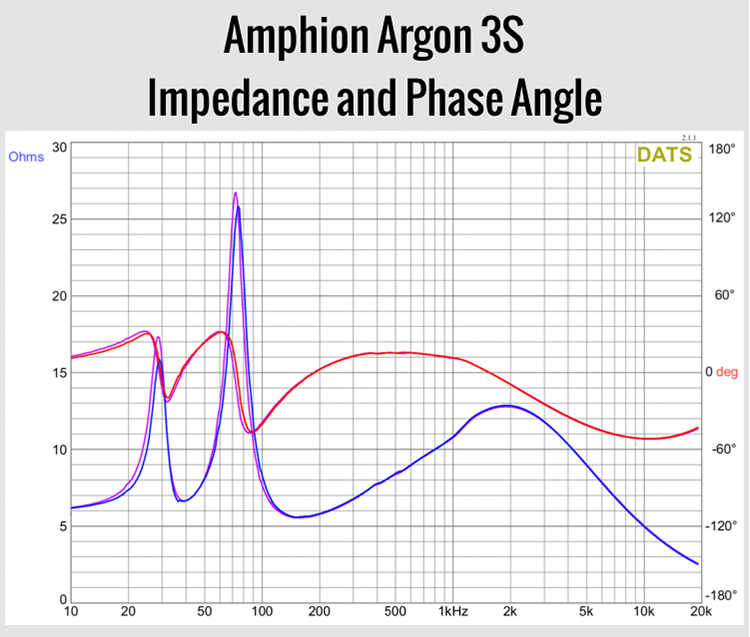
The Amphion Argon 3S presents an easy load to any competent amplifier. The impedance never falls below about 5.75 Ohms, except in the extreme treble. Both speakers match well, with the only real differences being slight variations in the bass impedance peaks that could be an artifact of the curve fit model. The saddle between the two impedance peaks reveals the passive radiator’s tuning to be at or just under 40Hz, which explains why Amphion went to a passive radiator. A 40Hz port of appropriate diameter in a cabinet this small would take up much of the interior volume and result in extreme pipe resonances, and an undersized port would chuff.
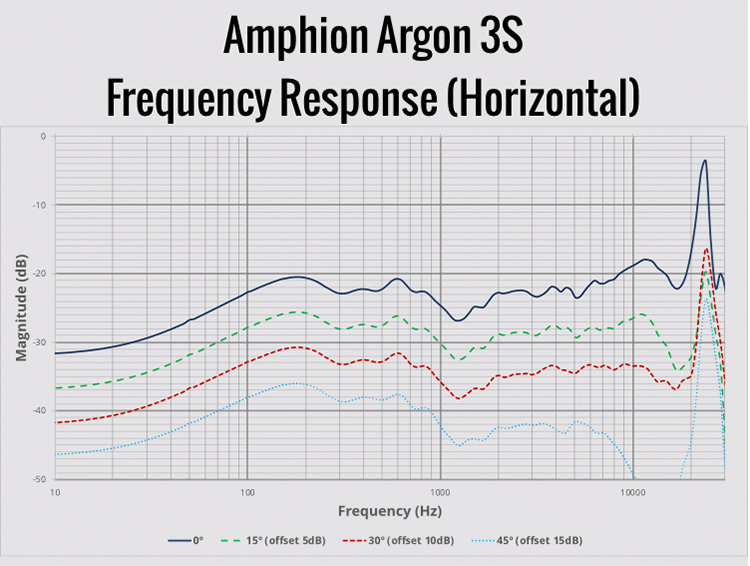
Except for a dip just below the crossover frequency, the on-axis frequency response has a rising trend of about 4dB over the 1kHz-10kHz decade. The tweeter has a very strong bell mode at about 24kHz, but subjectively that should not be an issue.
Generally, the off-axis curves nicely track the on-axis curve, though they converge somewhat at around 5kHz. The waveguide performs superbly.
As an aside, while one might expect a relative increase in lower midrange distortion due to the low crossover frequency, I found the opposite: all orders of distortion (not shown) were lower in the crossover region than they were over the woofer’s whole operating bandwidth. The secret is the waveguide, which both increases efficiency and lowers distortion over its working range.
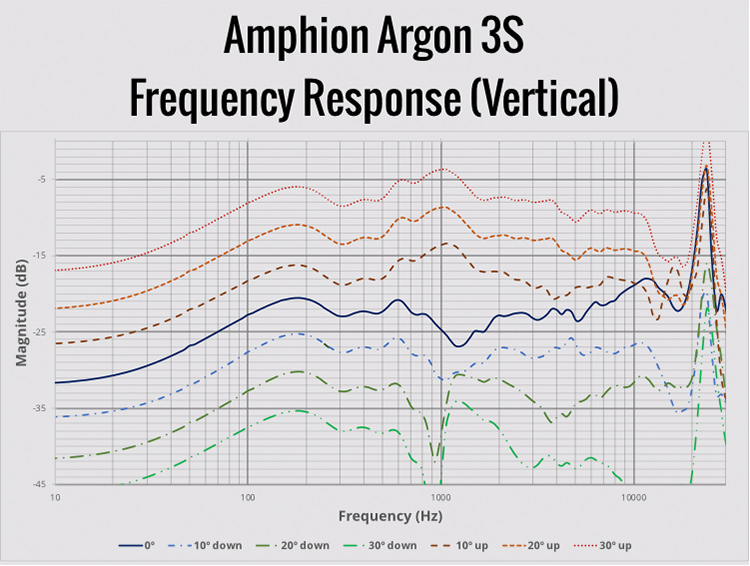
The interference pattern in the verticals suggests the acoustic crossover frequency is a couple of hundred Hertz higher than the claimed 1.6kHz. The curves indicate that the Amphion Argon 3S is best heard when the tweeter is on the same plane as the listener’s ears, or just slightly below. The midrange suckout below the speaker is likely a good thing in-room, because it reduces floor bounce.
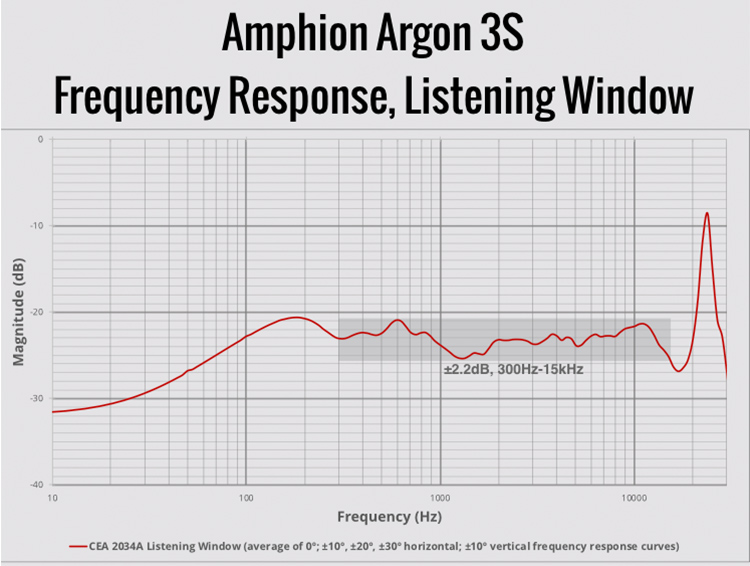
The listening window frequency response provides a visual representation of the perceived “first arrival” sound from a speaker. The CEA-2034A standard defines the listening window as an average across 60deg horizontal and 20deg vertical.
The Amphion Argon 3S has a listening window response both flatter and more U-shaped than one would expect from the horizontal frequency response graphs. The overall swing is reasonably tight: 4.4dB from 300Hz-15kHz. Most of the variation comes from that broad dip below the crossover frequency. Generally, a shallow but broad dip/peak is more audible than a deep but narrow dip/peak. Going over my listening notes, it seems the extra treble energy perceptually masked the slight midrange recession. For me, at least.
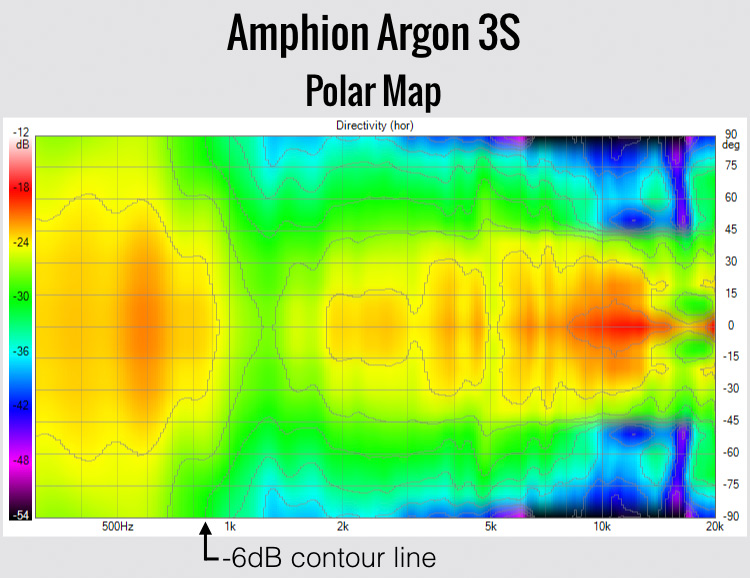
The horizontal polar map shows the total energy radiated across a semicircle around the speaker, at tweeter height. The horizontal pattern is roughly 120deg through most of the speaker’s range, except for a flare of energy at about 5kHz and a smaller flare at around 7kHz. These flares indicate resonances. This performance again shows the efficacy of Amphion’s waveguide design.
The normalized polar map shows the total energy radiated across a semicircle around the speaker, at tweeter height, normalized to the on-axis frequency response (i.e. if the on-axis frequency response were equalized completely flat).
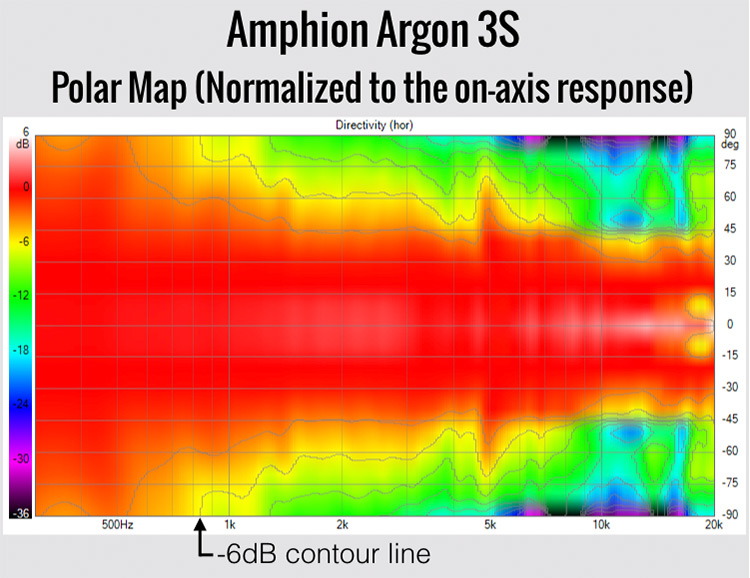
Here, we see the 5kHz resonance more clearly, as well as the outstanding pattern control provided by Amphion’s waveguide. No wonder they sounded so consistent across multiple seats! Interestingly, the on-axis and listening window frequency response curves both show dips at around 5kHz, where the polar map shows the speaker is putting out a lot of energy. That is a good example of why one needs to look at measurements in different forms to gain a complete picture of a speaker’s performance.
These polar maps were made in VituixCAD and published with the permission of the program author.
This bench section introduces power response and directivity index (DI) measurements. Measurements for power response and DI were taken horizontally at 10-degree intervals over 180 degrees (front to back) and mirrored, and vertically at 10-degree intervals over a full 360 degrees. These measurements are part of the CEA-2034A standard, though they are presented slightly differently here. Measurements presented here differ slightly.
The power response is a sum of a speaker’s total radiated power output as measured on a sphere. Under CEA-2034A DI is calculated as the difference between the listening window frequency response average and the power response. VituixCAD uses the old definition: the difference between the frequency response at a chosen reference angle and the power response. I chose a reference angle of 20 degrees because the frequency response at that angle was closest to the listening window frequency response.
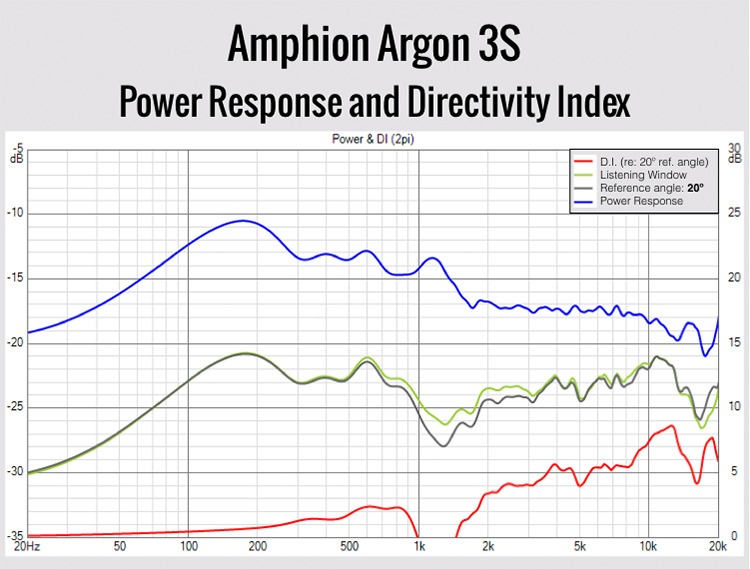
The power response reveals something very interesting about the Amphion Argon 3S’s design targets: it is very flat from 2kHz-10kHz. Other similarly scientifically inclined speaker companies generally target flat on-axis response and smoothly declining sound power. Perhaps, given these drive units, their waveguide, and these cabinet dimensions, Amphion considers a flat power response more “musically correct.”
Note also that the dip at around 5kHz in the listening window and 20deg frequency response curves correspond to a bump in the power response. That confirms the 5kHz resonance clearly visible in the polar maps, though it’s harder to visualize using power response and DI measurements unless you’re looking for it.
The in-room response is an average of 5 measurements per speaker, taken around the primary listening position. ARC Genesis was used to correct for the room below 250Hz, with Room Gain set at 1.5dB to fit the Argon 3S’s natural bass rise. (See ARC printouts above.)
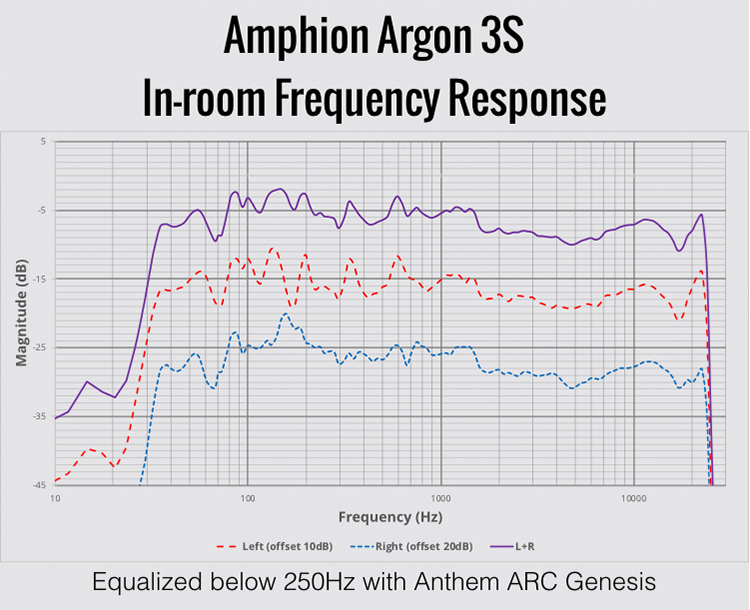
In-room measurements can tell you two things that semi-anechoic measurements cannot: realistic in-room bass extension and pair matching control. The Amphion Argon 3S goes uncommonly deep for such a small speaker, with extension all the way down to the mid-30Hz range in our room. That’s low enough for most music, though for greater bass headroom and smooth bass over a larger listening area one will ideally use 2 or 4 subwoofers. With room correction, one could also place them close to the front wall and get more free bass reinforcement without fear of bass overpowering the rest of the spectrum.
The in-room measurements also show Amphion’s truly exceptional pair matching. The midrange and treble response of the left and right speaker look nearly identical! The room is not perfectly symmetrical. The room response tracks so closely because, again, the Argon 3S’s waveguide provides superb pattern control. Note also that the Argon 3S are not sold as matched pairs, or even packaged in pairs. This spectacular pair-matching came from two speakers packed in separate boxes! While one would think that is expected at their price point, unfortunately, that is not always the case.
The in-room response measurements also show that Amphion’s Argon 3S puts a lot more energy in the 5-10kHz octave into this room than other speakers I have auditioned here, consistent with the flat power response. See the in-room response measurements for NHT C3, Tannoy Revolution XT 8F, and my usual speakers’ raw and corrected/equalized with Dirac Live! on the Bryston SP4 immersive sound processor.
However, the Amphion Argon 3S never sounded as piercing to me as my usual speakers did when equalized using Audyssey’s “Flat” curve. Those measurements, taken using the same procedure, are available in reviews of the Denon X4100W AVR and Marantz AV7702 SSP. There could be good psychoacoustic reasons for that. It would have been interesting to A/B the Argon 3S vs. my reference speakers equalized using Audyssey’s Flat curve, but I did not have the capability to do so.
Effect of the “treble +1dB” switch:

The switch generally provides the advertised 1dB treble boost. It is connected to passive circuits rather than an active filter, so a “perfect” 1dB boost is not expected. I never listened to the speakers with this switch in the +1dB position because I never felt the treble was too soft. In fact, I think a switch that engaged a specific treble cut would be more useful.
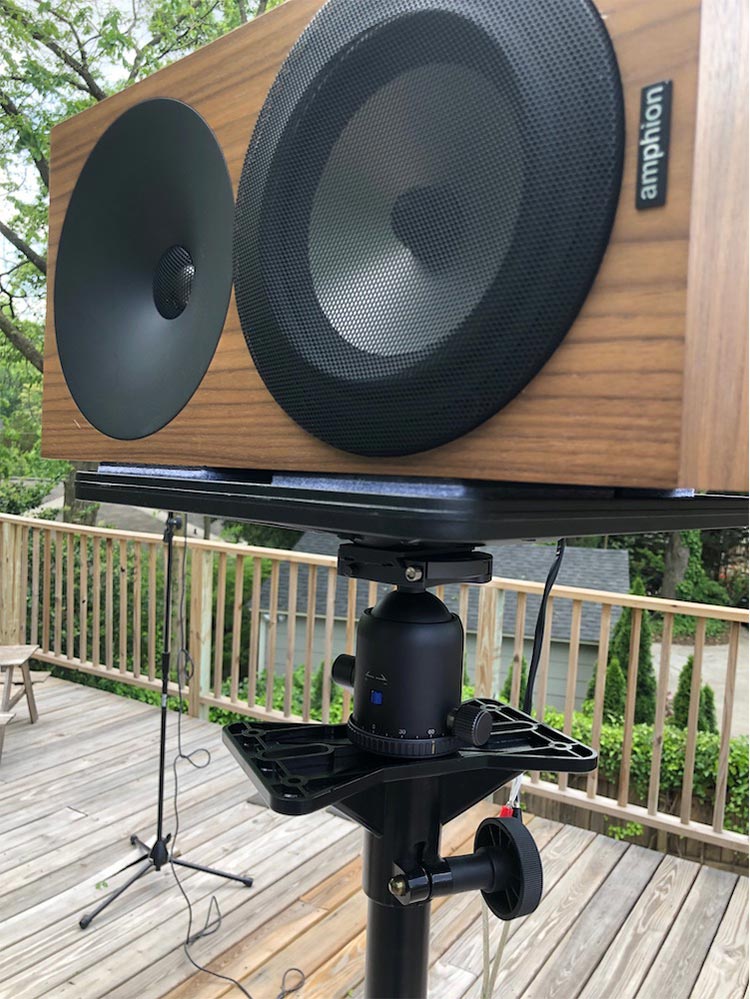
THE AMPHION ARGON 3S is a powerful pint-sized speaker focused on extracting every detail from your music.
- Well-designed waveguide
- Attractive cabinet
- Very strong bass extension considering the cabinet size
- Essentially perfect pair matching
- A treble-attenuation switch rather than a treble-boost switch
- More practical binding posts
- Protection for the rear-mounted passive radiator
The Amphion Argon 3S is a beautiful little speaker containing some impressive engineering. Amphion’s custom waveguide expertly imposes its will on the sound field, and – along with Amphion’s superb quality control – is why the right and left channel in-room measurements track each other very closely through the midrange and treble. The passive radiator allows a very low bass tuning considering the cabinet volume, and despite their small size they can move enough air to provide a taste of real deep bass.
The Amphion Argon 3S greatly rewards the analytic listener. However, at times when listening to them, I found it hard to exit an “analyze the music” mindset and escape into “relax and let the music wash over me.” Their sound is just different from, e.g., a Revel or TAD speaker.
I wonder if that difference arises because Amphion appears to have prioritized flat power response over a neutral first arrival. By contrast, most other speakers designed from first principles target flat on-axis response, along with (like Amphion) smooth off-axis performance. Those design choices provide a spectrally neutral first arrival and a smoothly declining power response. Instead of the pointless “more treble” switch, an option for a broad cut of about 2dB centered at about 10kHz would be a very nice addition to the Argon 3S. Due to the waveguide’s superb pattern control, such a switch could actually make the Argon 3S transform from flat power response to more or less flat on-axis response (with a slight midrange dip).
From my listening, I can see how such a sonic profile may “translate” well when mastering music. If you’re looking for a very detailed-sounding speaker that helps you closely inspect every piece of music played through them, or want to know what such a speaker sounds like, seek out the Amphion Argon 3S for an audition.


